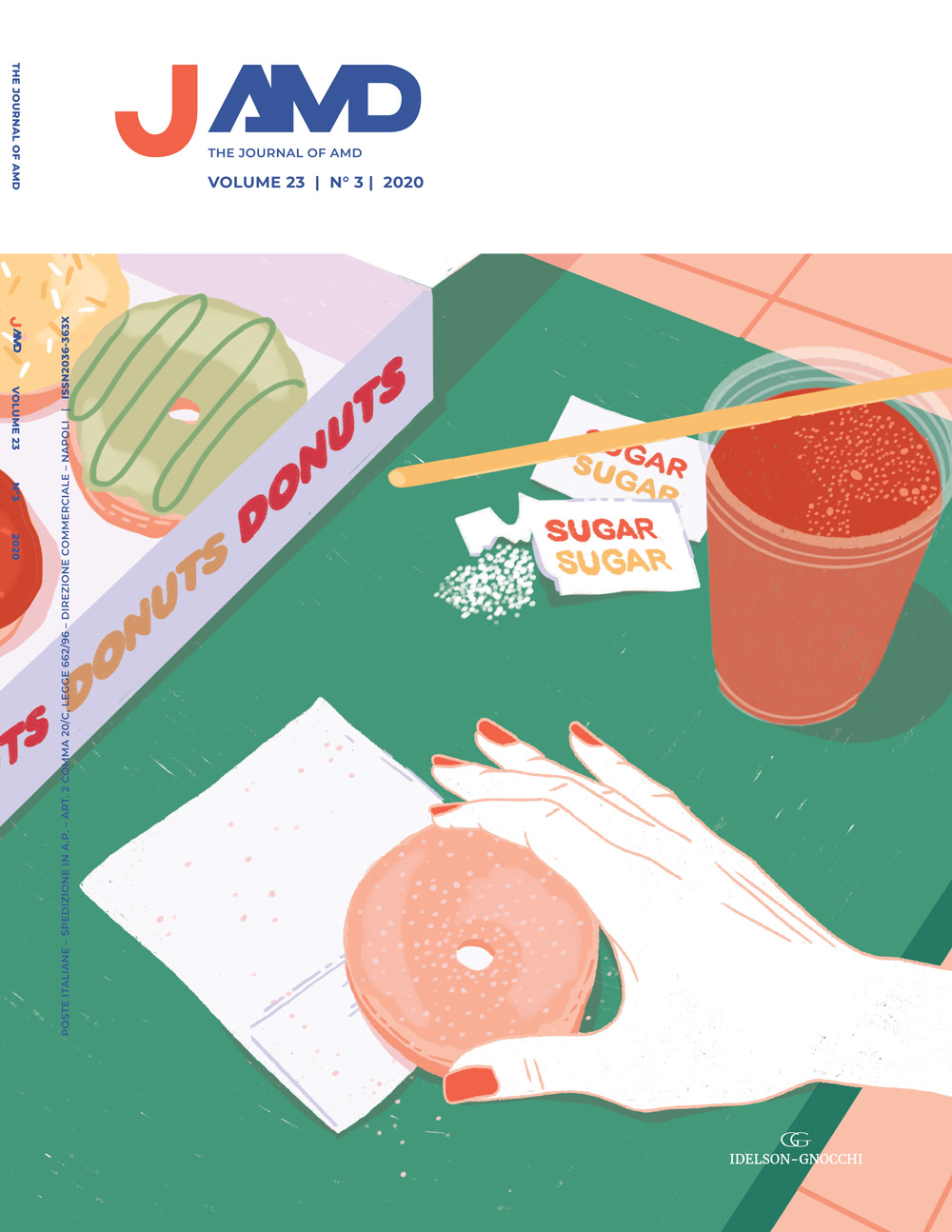Research article
Insulin DEgludec in hospitalized patients with type 2 diabetes (IDEOS Study): what effects on glycemic control, glycemic variability and hypoglycemia
JAMD 2020;23(3):170-180
Modern guidelines suggest the control of hyperglycemia in hospitalized patients through insulin therapy and the achievement of individualized glycemic targets, avoiding hypoglycemia, associated with a worsening of outcomes and a mortality increase. There is little evidence in literature on the use of new basal insulins in a hospital setting.
OBJECTIVE OF THE STUDY Document, in real life context, the use of insulin degludec and the results in terms of glycemic control, variability and hypoglycemia in hospitalized patients with type 2 diabetes, com pared to a population treated with traditional basal insulins.
DESIGN AND METHODS Prospective observational study on patients hospitalized in internist area. Personal and clinical data, in particular capillary blood levels on 4 daily points and hypoglycemia were collect ed. In a group of patients on traditional basal insulin therapy not at tar get, a switch to insulin degludec was performed.
RESULTS 65 patients (58.5% male) were enrolled: age 70.8±10.7 years, BMI 27.7 ± 4.4, HbA1c 8.4 ± 1.3% (average+/SD). 76.4% of patients had 3 or more comorbidities. 69.2% of patients were treated with basalbolus, 7.7% with basalplus, 16.9% with basal insulin alone. In the group treated with degludec (35 patients), a significant reduction in mean capillary glycaemia was obtained between the first day of hospitaliza tion or initiation of therapy and discharge in each time slot: 36.6 mg /dl fasting (p <0.0001), 30 mg/dl before lunch (p <0.005), 38.9 mg/dl before dinner (p <0.001) and 37.3 mg/dl bedtime (p <0.001) and also fewer hypoglycemia (20% had at least one daytime hypoglycemia, no subjects had nocturnal hypoglycaemia). In the group receiving insulin glargine for the entire period (30 patients), a significant reduction in capillary blood sugar levels is present only in the pre lunch range (43.8 mg / dl, p <0.001) and 26% of subjects had at least one daytime hypoglycemia and 2% nocturnal hypoglycemia. In the group switched to degludec, the mean capillary fasting blood glucose decreased from 176.6 ± 27.9 to 130.4 ± 36.6 mg/dl, that of predinner from 217.9 ± 36.7 to 170.9 ± 49.1 mg/dl, patients at target upon awakening increased from 10% to 65%, glycemic variability expressed as the mean of morning standard deviations fell from 45.2 to 25.6 and hypoglycemia decreased (% of patients with at least one daytime hypoglycemia from 25% to 15%, with nocturnal hypoglycemia from 5% to 0%). Conclusions The use of insulin degludec in hospitalized patients in medical area was effective and safe, with better glycemic control in every time slot, fewer hypoglycemia and reduced glycemic variability.
KEYWORDS basal insulins; hospitalized patients; hypoglycemia; glycemic variability.
Reviews
Breastfeeding and diabetes
JAMD 2020;23(3):181-189
Breastfeeding improves health outcomes for mothers and infants and reduces the risk of neonatal infections.
In particular lactation improves glucose tolerance in women with and without prior gestational diabetes and is associated with reduced risk of becoming overweight or obese later in life. Breastfed babies grow more slowly during infancy than formulafed babies and seem to have a lower risk to develop diabetes later in life. In women with type 1 diabetes breastfeeding was associated with a reduction in glucose variability and in insulin requirement.
SARS-CoV-2 infection has recently spread to Italy with important consequences on pregnancy management, mother and child health and mother-child contact.
To date no evidence confirmed SARS-CoV-2 vertical transmission from infected pregnant mother to their fetus. However it is well known that an infected mother can transmit the COVID-19 virus through respiratory droplets during breastfeeding or intimate contact.
Thus, exclusive breastfeeding is recommended for at least six months postpartum in women with and without diabetes, even if with known or suspected COVID-19.
Mothers with known or suspected COVID-19 should adhere to standard and contact precautions during breastfeeding.
It should be considered that following suggestions may change in the future when more evidence is acquired regarding SARS-CoV-2 infection.
KEYWORDS breastfeeding; diabetes; pregnancy; COVID-19.
The complex patient with diabetes and cardio-renal comorbidities: a management model proposal
JAMD 2020;23(3):190-200
Type 2 diabetes mellitus (DM) is a metabolic disorder and its prevalence has been increasing in the world population and represents one of the chronic diseases with the highest socioeconomic impact on the health systems. It is expected that in the next decade life expectancy and population aging will increase with the consequences of the increasing incidence of diabetes and its associated comorbidities.
(DM) is the main cause of chronic kidney disease and it is associated with a significant increasing in cardiovascular risk.
The coexistence of cardiac and kidney diseases on a metabolic basis, named “cardiorenal metabolic syndrome”, in elderly patients affected by multimorbidity increase their clinical and care complexity. In order to assess clinical complexity it is necessary to change paradigm from a reactive approach to a proactive one and the integration of territorial, hospital and social services according to the Chronic Care Model (CCM) is important. The proactive management of the complex patient suffering from chronic diseases and multimorbidity has been implemented at the National ARNAS Civico Hospital in Palermo with the MUSE (Multidimensional aSsessment of Elderly) project. The interaction between hospital and territorial services to respond to patients’ needs should be a priority. The hospital must therefore be conceived as a highly specialized center for chronic disease management that works with primary care according to a multidimensional and multidisciplinar model of care reducing rehospitalization and negative outcomes in patients affected by chronic diseases.
KEYWORDS diabetes mellitus type2; comorbidity; management model; complexity; cardiorenal syndrome.
Surveys
On line ‘Diabetes and Smoking’ Survey: results and com¬ments
JAMD 2020;23(3):201-209
Cigarette smoking increases the risk of micro and macrovascular complications among subjects with diabetes. Smoking is also associated with both beta-cell function deterioration and insulin resistance.
In the modern approach to the management of the global cardiovascular risk of the diabetic patient, cigarette smoking needs the same attention as other major factors (glycaemia, blood pressure and cholesterol). The prevalence of smokers, according to the AMD 2020 Annals, is 16,9% among type 2 diabetic patients and 25,9% among type 1 diabetic patients. These rather high percentages, in line with the overall population data, suggest the need of a greater and more effective engagement by diabetes team to discouraging smoking. The ‘Diabetes and Smoking’ Survey was designed by the ‘Diabetes and Addictions’ AMD-SID Lazio Working Group in order to analyze the perception that diabetologists have of smoking, to explore their specific knowledge of the smoking treatment, to highlight the interventions adopted to discourage smoking and to identify critical issues in clinical practice.
The Survey has shown, first of all, the need to sensitize diabetologists to the topic of smoking: not everyone believes that smoking is addictive and not everyone adequately investigates it in anamnesis and includes it in medical records. The Survey also identified specific knowledge required on treatments for cigarette smoking addiction: diabetologists know little about drugs for smoking treatment, have false beliefs about new devices for smoking (electronic cigarettes and heated tobacco) and are little or not in contact with Anti-Smoking Centers.
Currently, the intervention strategy preferred by diabetologists is to inform patients about smoking related damage, an approach of proven low efficacy (knowledge is not enough to change behaviors).
Psychologists are rarely part of the diabetes Team, but even when this happens, they are not involved in the smoking addiction treatment. Finally, the Survey highlighted that the main obstacle perceived by diabetologists in the fight against smoking is the lack of a structured care process.
The objective of the ‘Diabetes and Addictions’ Working Group is filling the gap between overall diabetes care (control and improvement of any micro and macrovascular risk factor) and smoking addiction treatment.
KEYWORDS addiction; cessation; minimal advice; antismoking centers; structured care process.
Simposio
Sugar. Is it seriously harmful to health?
JAMD 2020;23(3):210-220
Sugars are essential for life because they represent the main source of energy for living beings. From the second post-war period their consumption has had a continuous and progressive increase for many reasons. This trend especially with regard to the increasingly significant use of “free” sugars in beverages can pose a serious health risk, in particular for the development of cardiovascular disease, obesity, liver cirrhosis, dementia and diabetes mellitus both of type 1 and 2. The WHO strongly recommends reducing the intake of free sugars, hoping for a reduction to <5% of daily calorie intake, and health policy interventions can help to achieve this goal by changing its free and uncontrolled use.
KEYWORDS sugar; health; diabetes; sugar sweetened beverages; cardiovascular risk.
Unequal in diabetes: the role of policies
JAMD 2020;23(3):221-223
A tax for health: international experiences
JAMD 2020;23(3):224-228
Obesity, type 2 diabetes and their complications are consistently increasing all around the world, both in developed and in developing countries. Sweetened beverages consumption is considered an important contributor to the widespread of these diseases. This led many countries worldwide to create a “sugar tax”, a levy on sugar content of these beverages, to discourage the consumption of such drinks. This article will examine some of the most significant examples of sugar taxes worldwide and their current and potential impact on drinks sales and consumption and on incidence and prevalence of consequent metabolic diseases. “sugar tax”, “obesity, “type 2 diabetes”, “sweetened beverages”.
KEYWORDS obesity; sugar tax; type 2 diabetes; sweetened beverages.
Between politics and every day life
JAMD 2020;23(3):229-230
How to overcome sugar addiction?
JAMD 2020;23(3):231-236
Sugar consumption activates the mesocorticolimbic system in a very similar way to substance abuse. But if all addictions initially start with a feeling of pleasure, as in the case of highly palatable foods and sugar rich diets, then why should I abandon something that makes me feel good? And then why does one continue to abuse food despite the negative consequences.
There are various ways to deal with the different addictions. However, the problem with sugar addiction, or even more generally with food addiction, is that there is no awareness that the relationship with food can represent an addiction in some cases, and the tools are lacking to identify the most suitable professional figures to help manage the situation when needed. Therefore, the approach to the problem must be multidisciplinary. A methodology based on three fundamental elements is proposed: 1. Training the patient with regard to her/his addiction, providing objective and scientific information, 2. Providing the patient with the right tools, i.e. ‘know-how’, 3. Preventing relapses.
Our patients’ stories report how they have learned to manage their emotional needs without escaping, to observe their thoughts by recognising their distortions, to identify what triggers their spasmodic desire for food and understand their behaviour in depth, and to connect better with themselves and others, also sharing the painful emotions along the way!
KEYWORDS sugar addiction; food addiction; awareness; addiction treatment; multidisciplinary team.
Attività dei gruppi
Stress e burnout ai tempi del Covid 19
Stress and burnout in the time of Covid 19
JAMD 2020;23(3):237-239
Il Progetto InsideMe Diabete
“InsideMe Diabete” Project
JAMD 2020;23(3):240-241
La pandemia ha solo accentuato le diseguaglianze… Spunti per riflettere
The pandemic has only accentuated inequa¬lities… Ideas for reflection
JAMD 2020;23(3):242-245
Le news di AMD
Newsletter Annali AMD n. 30
AMD Annals Newsletter n. 30
JAMD 2020;23(3):246-248




